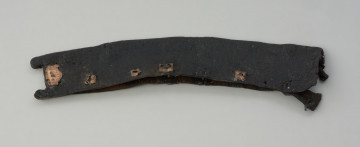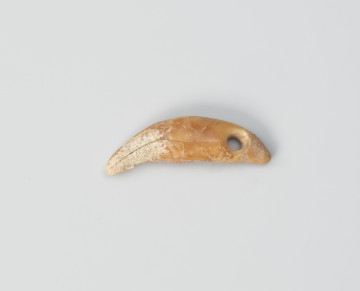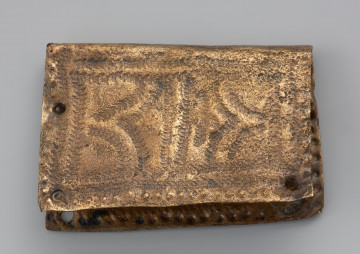
Leather sheath
476 — 1100
National Museum in Szczecin
Part of the collection: Middle Ages
In the early Middle Ages, some small everyday objects were carried in leather pouches attached to belts. They were made from a single piece of leather properly cut and fitted to the shape of the object. The edges of the pouches were connected with a strip of leather or sewn together with thread. Metal fittings, usually made of copper alloys, were a common element reinforcing and decorating these pouches. They were attached in various places, usually those most prone to tearing or cutting. In the early Middle Ages, in addition to fittings made of non-ferrous metals, elongated pieces made of antlers were sometimes also used. In the late Middle Ages, on the other hand, iron became the dominant raw material for the production of the characteristic long fittings. This early medieval fitting from Cedynia was discovered in an 11th-century skeletal grave along with an iron knife and two bronze rivets. It was made from a piece of thin rectangular copper alloy plate. Both sides of the piece bear single, convex points surrounded by smaller bulging protrusions in the central part. The ornament was made by punching. The edges are decorated with delicate engraving similar to herringbone. The piece was originally attached to the bottom of the leather sheath with two copper rivets.
Grzegorz Durdyń
Author / creator
Dimensions
cały obiekt: height: 2.1 cm, width: 2.6 cm
Object type
fitting, adornment
Technique
engraving, fine detail finishing, bending, cutting
Material
copper alloy
Origin / acquisition method
field research
Creation time / dating
Creation / finding place
Owner
Muzeum Narodowe w Szczecinie
Identification number
Location / status

476 — 1100
National Museum in Szczecin

951 — 1050
National Museum in Szczecin

1001 — 1100
National Museum in Szczecin
DISCOVER this TOPIC
National Museum in Lublin
DISCOVER this PATH
Educational path